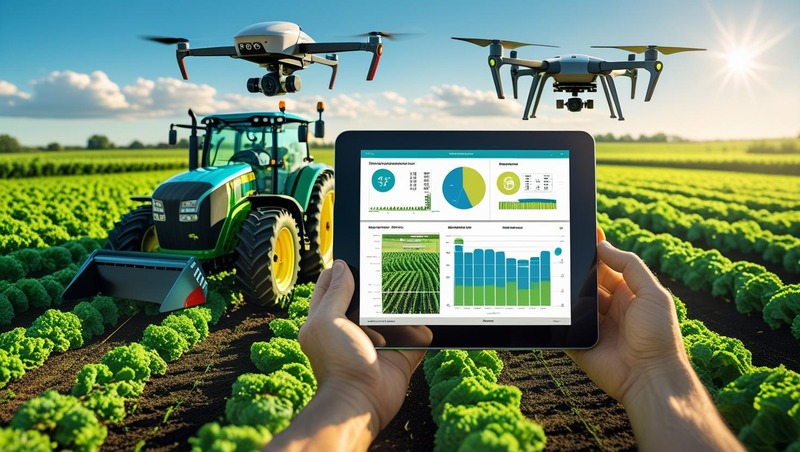In 2025, precision farming is undergoing a dramatic evolution, powered by the transformative capabilities of Artificial Intelligence (AI). As the global population continues to rise and climate change reshapes traditional agricultural patterns, AI is emerging as a vital tool to help farmers maximize yields, reduce environmental impact, and make data-driven decisions with unprecedented accuracy.
At the core of this transformation is data—collected from satellites, drones, ground-based sensors, and smart farm machinery. AI systems analyze this vast data in real-time to deliver insights that allow farmers to optimize every aspect of crop production. From planting schedules to irrigation patterns and pest control, AI algorithms are reshaping how farms are managed and operated.

One of the most impactful uses of AI in precision agriculture is predictive analytics. By analyzing weather forecasts, soil conditions, and crop health data, AI models can accurately predict the best times for sowing and harvesting. These predictive tools also help anticipate pest infestations or disease outbreaks before they happen, allowing farmers to take preemptive action, saving crops and reducing chemical use.
AI is also enhancing precision irrigation. Smart systems use machine learning to analyze moisture levels, plant growth stages, and weather patterns to deliver just the right amount of water when and where it is needed. This conserves water—a critical resource—while ensuring optimal crop growth.
Moreover, AI-powered drones and robotics are becoming common on farms in 2025. Equipped with advanced computer vision and deep learning algorithms, these machines can detect plant diseases, measure crop health, and even perform tasks like weeding and harvesting with incredible precision. This not only reduces labor costs but also increases overall farm efficiency and sustainability.
Another key area is livestock management. AI systems monitor animal behavior, track feeding patterns, and detect early signs of illness using sensors and real-time analytics. Farmers receive instant alerts on mobile devices, allowing for faster interventions and healthier livestock.
Importantly, AI is making farm management platforms more intelligent. These platforms integrate satellite imagery, weather data, and machine performance metrics to give farmers a holistic view of operations. With AI-driven recommendations, they can plan better, reduce input costs, and boost productivity while maintaining environmental balance.
Frequently Asked Questions (FAQs) on the Precision Farming Market
- What is precision farming?
Precision farming, also known as precision agriculture, is a farming management approach that uses technologies such as GPS, IoT, sensors, AI, and data analytics to monitor and optimize agricultural practices. The goal is to increase productivity, reduce waste, and enhance sustainability.
- Why is the precision farming market growing?
The market is expanding due to increasing global food demand, the need for resource-efficient farming, rising labor costs, climate change challenges, and the adoption of advanced technologies like AI, drones, and big data in agriculture.
- What are the main components of precision farming?
Core components include GPS-guided equipment, variable rate technology (VRT), remote sensing, yield monitoring, soil sensors, drones, and farm management software.
- Which technologies are driving the precision farming market?
Key technologies include artificial intelligence (AI), machine learning, IoT (Internet of Things), robotics, geographic information systems (GIS), unmanned aerial vehicles (UAVs), and satellite imagery.
- What are the benefits of precision farming?
Precision farming offers benefits such as increased crop yields, reduced input costs (fertilizer, water, pesticides), better resource management, enhanced decision-making, and improved environmental sustainability.
- Who are the major players in the precision farming market?
Leading companies include Deere & Company (John Deere), Trimble Inc., AGCO Corporation, CNH Industrial, AGCO Corporation, Topcon Positioning Systems, and Ag Leader Technology.
See More Latest Semiconductor Reports:
Smart Irrigation Market by System Type (Weather-based, Sensor-based), Controllers, Sensors (Soil Moisture Sensors, Temperature Sensors, Rain/Freeze Sensors, Fertigation Sensors), Water Flow Meters, Greenhouses, Open Fields – Global Forecast to 2030
UQD Coupling Market by Type (Fixed, Rigid), Material (Steel, Brass, Aluminum, Polymer, Carbon Fiber Reinforced, Composite), Vertical (Data Center, HPC, Liquid, IT & Electronics Cooling, Energy Storage, Industrial Automation) – Global Forecast to 2030
Lithium-ion Battery Market by Battery Type (NMC, LFP, LCO, LTO, LMO, NCA), Cell Type (Prismatic, Pouch, Cylindrical), Capacity (<50 kWh, 50-100 kWh, >100 kWh), Energy Storage (Residential, Utilities) Consumer Electronics, Medical – Global Forecast to 2033
